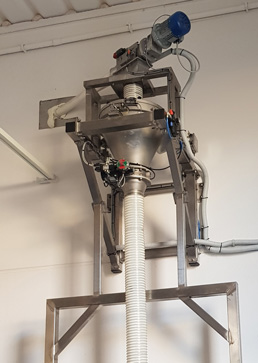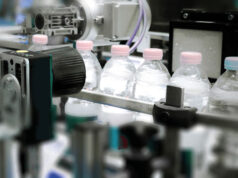Un cliente aveva la necessità di svuotare dei big bags contenenti il proprio mix di farine trasferendone il contenuto senza demiscelarlo durante il trasporto.
Il prodotto in polvere andava sottoposto a una vagliatura di controllo e convogliato al disopra di due impastatrici poste ai due lati della sala impasti. Le quantità trasferite dovevano essere impostabili da un minimo di 5 kg ad un max di 30 kg/batch e l’impianto doveva essere supervisionabile da remoto e sodisfare i requisiti industria 4.0.
Soluzione
Dopo attento sopralluogo i tecnici GIMAT hanno optato, tra le varie soluzioni possibili, per quella che meglio rispecchiava i parametri tecnici ed economici del cliente. Nello specifico la scelta è andata su una soluzione idonea per aree classificate Atex 21-22 e conforme alla direttiva 1935/2004 per contatto alimentare oltre che alla direttiva macchine 2006/42/CE, composta da:
• N°1 Struttura di sostegno per svuotamento big bag con tramoggia vibrata per consentire lo svuotamento sicuro e a tenuta polvere del Big Bag.
• N°1 Vibrovaglio compatto, appositamente realizzato e integrato nella struttura, con la funzione di setacciare il prodotto da eventuali corpi estranei contenuti nel big bag stesso.
• N°1 Agitatore con funzione di agevolare la discesa del prodotto (amidi) poco scorrevoli all’interno del sistema di trasporto sottostante.
• N°1 Sistema di trasporto multiplo a coclee flessibili, facilmente pulibili, che ha consentito di trasferire la miscela in polvere per lunghi tragitti anche curvilinei senza demiscelarla e lasciandola inalterata nelle sue caratteristiche. Il sistema di trasporto è stato concepito in tre linee: una di elevazione in quota per circa 8 mt e due linee orizzontali, una per ogni impastatrice, di cui una da 15 mt circa ed una da 25 mt circa.
• N°2 tramogge pesate da 100 lt circa per ricevere con controllo di peso la miscela dalla rispettiva linea di trasporto. Il sistema di trasporto a coclea flessibile, comandato da inverter, si è prestato particolarmente ad effettuare il dosaggio accurato nelle tramogge stesse. In questo modo quando dalla sala impasti veniva richiesta la quantità necessaria per l’impastatrice sottostante questa veniva scaricata verticalmente in modo quasi istantaneo in quanto già preparata e dosata durante il tempo di impasto precedente.
• Armadio di Comando con PLC Siemens S7 1200 e pannello HMI generale fronte quadro nonché n°2 junction box con relativi HMI per controllo delle singole dosate indipendenti sulle due impastatrici data anche dalla necessità di comandare l’impianto da due sale distinte. Tutti i pannelli e l’impianto sono stati messi in rete con accesso da remoto e scambi dati con il gestionale aziendale quali storico allarmi e storico dosaggi nonché ricette effettuate.
Creating plants that fully meet requirements
Requirement
A client needed to empty bulk bags containing its special flour blend, moving the contents without altering the blend during movement.
The powdered product was subject to control by sifting and was conveyed over two processors placed one on each side of the dough-mixing area.
The quantities conveyed had to be settable from a minimum of 5 kilograms to a maximum of 30 kg/batch, and the system had to be subject to supervision via remote and satisfy the requisites of industry 4.0.
Solution
After visiting and inspecting the plant carefully and evaluating various possible solutions, the GIMAT experts opted for the one that most closely met the client’s technical and economic parameters.
Specifically, the choice fell on a solution suitable for areas classified Atex 21-22 and conforming with directive 1935/2004 for contact with food products, as well as with the machine directive 2006/42/CE, consisting of:
• 1 Supporting structure for emptying bulk bags with vibrating hopper to ensure secure emptying and dust seal of the Bulk Bag.
• 1 Compact vibrating screen, specifically designed and integrated in the structure, with the function of sifting the product to remove any foreign bodies that might be contained in the bulk bag.
• 1 Agitator with the function of facilitating the descent of products (starches) that tend not to slide easily within the underlying conveyor system.
• 1 Multiple conveyor system with flexible screws that are easy to clean and can convey the powder blend over lengthy sections even incorporating bends without allowing the mixture to separate and ensuring that its characteristics remain unchanged. The conveyor system is conceived as divided into three lines: an elevated line of about 8 meters and two horizontal lines, one for each dough-mixing installation, of which one is about 15 meters long and the other about 25 meters long.
• 2 weighing hoppers with about 100 litres capacity to receive the mixture with weight control from the respective conveyor lines. The conveyor system with flexible screws, controlled by an inverter, lends itself particularly well to ensuring accurate batching in the hoppers. This means that when the dough-mixing areas call for the quantities necessary for the underlying blenders they are discharged vertically and almost instantaneously as they have been prepared already and batched during the preceding blending time.
• Control Cabinet with Siemens S7 1200 plc and general HMI panel on the front, as well as 2 junction boxes with relative HMI for control of individual batches, independent of the two dough-blending lines, given also the need to control the system from two separate areas. All the panels and the system as a whole have been networked with access by remote control and exchanges of data with the company’s digital system, including alarm history and batch history, as well as recipes used.










